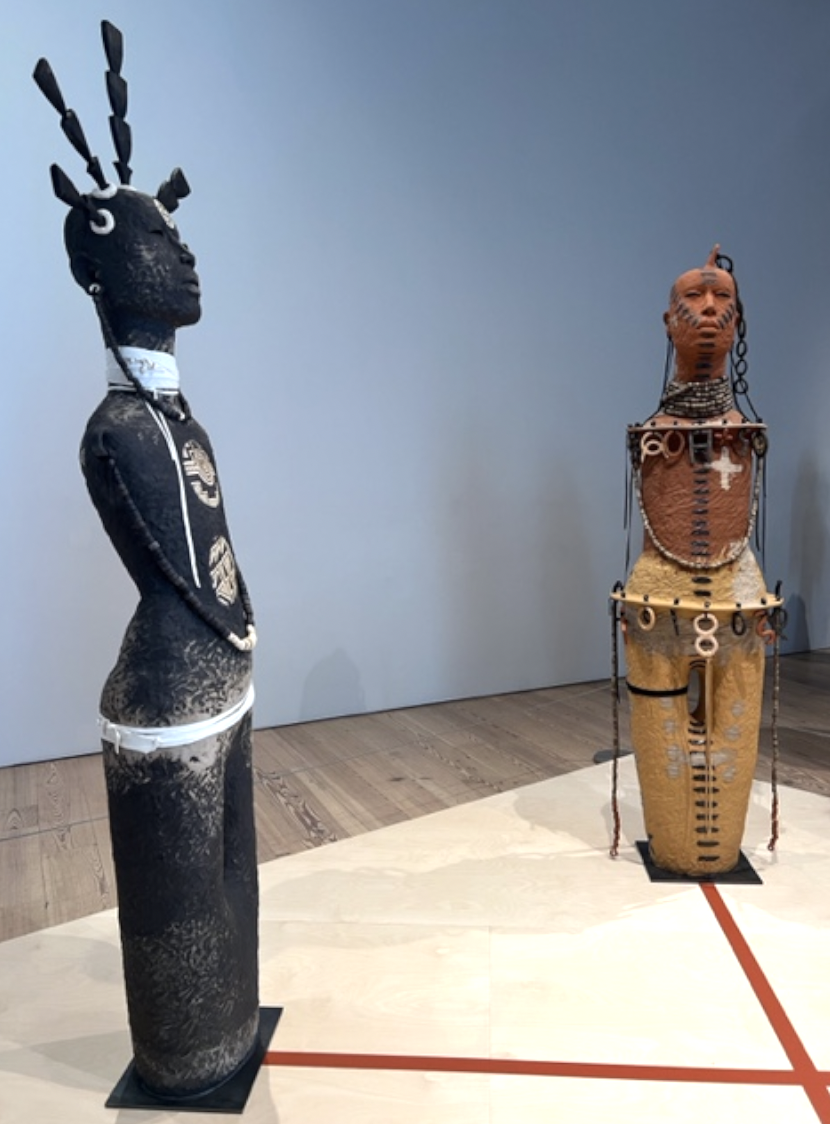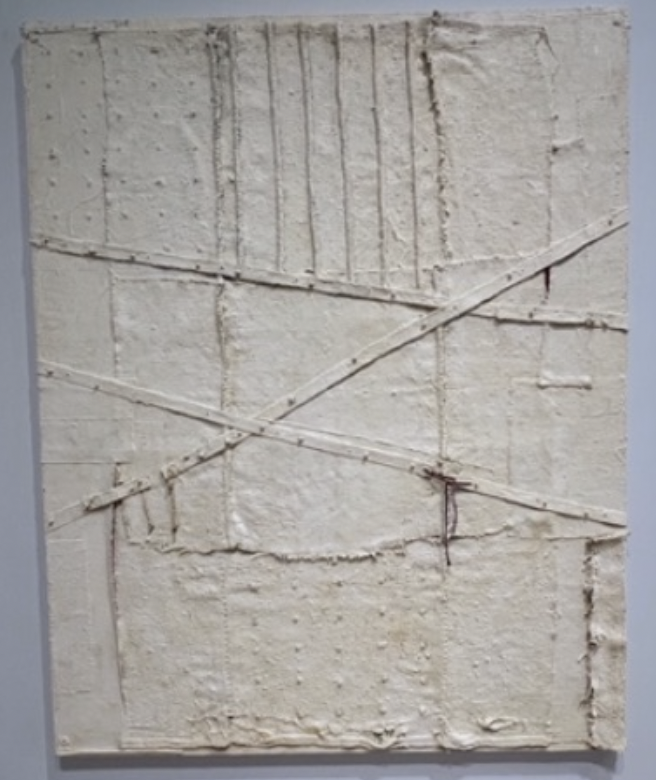WHITNEY BIENNIAL REVIEW
APRIL 2024
The 2024 Whitney Biennial has once again opened, albeit a smaller iteration than in recent years, with only 44 artists taking up just two floors in the galleries. The title of this year's theme, "Even Better Than the Real Thing", is acknowledging that AI (Artificial Intelligence) is complicating our understanding of what is real, and that talk around gender and authenticity is being used politically and legally to perpetuate transphobia and restrict bodily autonomy. The artists featured in this exhibition are committed to confronting the legacies of marginalized peoples in terms of race and gender, so they have been provided a space where some of these difficult ideas can be engaged and considered.
Below are six of our favorite artists and works from the show....
SUZANNE JACKSON
Suzanne Jackson, born in 1944, is finally enjoying acclaim after decades in obscurity. These recent paintings, known as "anti-canvases," are abstract and suspended in space without traditional supports. Jackson builds these works by massing and layering wet acrylic paint on dried acrylic paint. The resulting biomorphic armature is further enriched with physical elements like seeds, peanut shells, bells, leather straps, and old ballet costumes.
Since 1966, Suzanne Jackson has lived in Savannah, GA; she taught in the Savannah College of Art and Design's painting department until 2014. Her recent accolades include The Jacob Lawrence Award from the Academy of Arts and Letters, an Anonymous Was A Woman Grant, and a Joan Mitchell Foundation Painters & Sculptors Grant. Jackson will have a solo show of works on paper in New York in September, with early drawings, monumental sculptural works from the early 2000s, and recent "environmental abstractions", which include found papers suspended in pure acrylic paint.
EAMON ORE-GIRON
Eamon Ore-Giron has developed a cross-cultural practice that includes painting, music and video. In this presentation, he has returned to his "Talking Shit" series, which he began in 2017 while living in Guadalajara, Mexico. Ore-Giron is reimagining deities from ancient Peruvian and Mexican cultures and having conversations with the symbols and mythology that they represent. He is focusing on Andean folklore and has depicted Amaru, a powerful creature related to water and the underworld, as a zigzagging abstract dragon. He has also depicted the mythological rainbow made by the creation god Viracocha as a celestial double-headed snake moving through the sky.
Born in Arizona to a Peruvian father and a mother of Irish descent, Eamon Ore-Giron grew up in Tucson, where indigenous, Latino, Mexican, and white American cultures intersect. He later spent formative time in Mexico City as well as Huancayo and Lima, Peru, before relocating to Los Angeles, where he is currently based. Ore-Giron was recently selected to realize major public commissions by the New York Metropolitan Transportation Authority and LA Metro for subway stations in Brooklyn and Los Angeles, respectively.
ROSE B. SIMPSON
Rose B. Simpson, who lives and works in Santa Clara Pueblo in northern New Mexico, makes mixed-media and clay sculptures. She came of age in a multigenerational lineage of artists working with clay, and her practice is marked by indigenous traditions. In her exhibition, "Daughters: Reverence", four figures gaze at one another, creating a kind of force field of protection and solidarity that stands in contrast to an unstable world. Simpson's lifework is a seeking out of tools to use to heal damages she has experienced as a human being during the postmodern and postcolonial era. Not only are the figures imbued with strength through their formal relationship to each other and through the implied shared ancestry in the work's title, but also through the symbolic details adorning them. The artist has said the plus signs represent direction and guidance. This work continues the artist's practice of making larger-than-life clay sculptures that are often abstracted portraits, a process that Simpson has described as an act of "witnessing" in the community.
On April 11th, Simpson's Madison Square Park public art commission, Seed, will be unveiled, consisting of one 4-foot bronze figure and seven 18-foot outdoor weathered-steel statues. Simultaneously, she will show a different interpretation of Seed in bronze at a smaller 8-foot scale at Inwood Hill Park in Upper Manhattan. The Norton Museum in West Palm Beach, FL is also hosting a two-woman show with Simpson and her artist mother, Roxanne Swentzell.
TAKAKO YAMAGUCHI
Takako Yamaguchi's recent seascapes use meticulously rendered zigzags, tubes, and lines to suggest weather and other natural elements. They reflect Yamaguchi's experimentation with what she calls "abstraction in reverse," or taking recognizable forms, like clouds or waves, and abstracting them to the point of pattern - moving backwards in time from pure abstraction toward naturalism, pausing to capture a moment of “semi-abstraction” somewhere along the way. The resulting paintings work against Western art historical ideas of "pure" abstraction. Additionally, the luminous surfaces are intentionally decorative and structured using graphic techniques drawn from Mexican muralism and Japanese print design.
Takako Yamaguchi, born in 1952, currently lives and works in Los Angeles, California. She received a BA from Bates College in Lewiston, Maine in 1975 and a MFA from the University of California, Santa Barbara in 1978.
HARMONY HAMMOND
Harmony Hammond has been a key figure in the feminist art movement for more than half a century, using her unique approach to minimalism to advance narratives around gender politics and identity. Since the start of the millennium, Hammond has been focusing on modernist-style paintings and fabric sculpture, creating pieces similar to the ones currently on view at the Whitney. She relies on patterns and repetition to suggest a new perspective while evoking sewing or quilting, which historically have been characterized as feminine. However, the artist refuses to make these objects delicate or subtle, giving us instead a brash statement of power.
Aside from her own artwork, Hammond is known as one of the co-founders of AIR in 1972, the first women's cooperative art gallery in New York. Hammond's paintings are held in the permanent collections of over 35 museums, including the MoMA, Minneapolis Institute of Arts, and Walker Art Center, in addition to the Whitney. She will have work in a group exhibition at New Mexico Museum of Art in Santa Fe, which will be on view from June 8-May 4, 2025.
KIYAN WILLIAMS
In Kiyan Williams' outdoor sculpture "Ruins of Empire II" or "The Earth Swallows the Master's House," the north facade of the White House, which is composed of earth, leans on one side and sinks to the floor. The idea that earth carries history is something that Williams has explored extensively in their artistic practice. Here, the labor history embedded in the dirt points to a fragility in our political foundations, while the earth's erosion embodies the idea that institutions are toppling.
By embracing fragments and cracks, the artist's pieces are reminiscent of ancient ruins or relics that conjure up decay and capacities for resilience. While making, unmaking, and remaking, Williams creates works that question power dynamics. Soil, in particular, is a recurring material and metaphor that Williams uses to delve into American history and identity, thus unearthing the historical and ongoing forces that have shaped, and tightly tied together, bodies and land.






